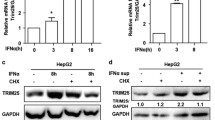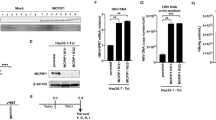Abstract
Hepatitis B virus (HBV) replicates noncytopathically in hepatocytes, but HBV or proteins encoded by HBV genome could induce cytokines, chemokines expression by hepatocytes.IL-12 is a typical proinflammatory cytokine that plays a critical role in host defense against pathogens, including the HBV. However, the role of IL-12 in chronic hepatitis B (CHB) remains unclear. The aims of this study were to detect the expression of IL-12 in CHB patients and explore the molecular mechanism of HBV-induced IL-12 expression. The results showed that serum levels and hepatic expression of IL-12 were significantly upregulated in CHB patients. HBx protein increased IL-12 expression in a dose-dependent manner. Furthermore, inhibition of PI3K/Akt significantly decreased the HBx-induced IL-12 expression and Akt activation. Taken together, these results indicate that the molecular mechanism of HBV-induced IL-12 expression involves activation of the PI3K/Akt pathway by HBx, leading to transactivation of the IL-12 p35 and p40 promoters.







Similar content being viewed by others
References
McMahon BJ (2009) The natural history of chronic hepatitis B virus infection. Hepatology 49:S45–S55
Lok AS, McMahon BJ (2009) Chronic hepatitis B: update 2009. Hepatology 50:661–662
Colgrove R, Simon G, Ganem D (1989) Transcriptional activation of homologous and heterologous genes by the hepatitis B virus X gene product in cells permissive for viral replication. J Virol 63:4019–4026
Ganem D, Prince AM (2004) Hepatitis B virus infection—natural history and clinical consequences. New Engl J Med 350:1118–1129
Rawat S, Clippinger AJ, Bouchard MJ (2012) Modulation of apoptotic signaling by the hepatitis B virus X protein. Viruses 4:2945–2972
Watford WT, Moriguchi M, Morinobu A et al (2003) The biology of IL-12: coordinating innate and adaptive immune responses. Cytokine Growth Factor Rev 14:361–368
Guidotti LG, Chisari FV (2000) Cytokine-mediated control of viral infections. Virology 273:221–227
Rossol S, Marinos G, Carucci P et al (1997) Interleukin-12 induction of Th1 cytokines is important for viral clearance in chronic hepatitis B. J Clin Investig 99:3025
Trinchieri G (2003) Interleukin-12 and the regulation of innate resistance and adaptive immunity. Nat Rev Immunol 3:133–146
Beckebaum S, Cicinnati VR, Zhang X et al (2003) Hepatitis B virus-induced defect of monocyte-derived dendritic cells leads to impaired T helper type 1 response in vitro: mechanisms for viral immune escape. Immunology 109:487–495
Cavanaugh VJ, Guidotti LG, Chisari FV (1997) Interleukin-12 inhibits hepatitis B virus replication in transgenic mice. J Virol 71:3236–3243
Ma X, Chow JM, Gri G et al (1996) The interleukin 12 p40 gene promoter is primed by interferon gamma in monocytic cells. J Exp Med 183:147–157
Gri G, Savio D, Trinchieri G et al (1998) Synergistic regulation of the human interleukin-12 p40 promoter by NFκB and Ets transcription factors in Epstein-Barr virus-transformed B cells and macrophages. J Biol Chem 273:6431–6438
Cappiello MG, Sutterwala FS, Trinchieri G et al (2001) Suppression of IL-12 transcription in macrophages following Fcγ receptor ligation. J Immunol 166:4498–4506
Manetti R, Parronchi P, Giudizi MG et al (1993) Natural killer cell stimulatory factor (interleukin 12 [IL-12]) induces T helper type 1 (Th1)-specific immune responses and inhibits the development of IL-4-producing Th cells. J Exp Med 177:1199–1204
Hsieh C-S, Macatonia SE, Tripp CS et al (2008) Development of TH1 CD4+ T cells through IL-12 produced by listeria-induced macrophages. J Immunol 181:4437–4439
Perussia B, Chan S, D’andrea A et al (1992) Natural killer (NK) cell stimulatory factor or IL-12 has differential effects on the proliferation of TCR-alpha beta+, TCR-gamma delta+ T lymphocytes, and NK cells. J Immunol 149:3495–3502
Okamura H, S-i Kashiwamura, Tsutsui H et al (1998) Regulation of interferon-γ production by IL-12 and IL-18. Curr Opin Immunol 10:259–264
Fantuzzi L, Puddu P, Varano B et al (2000) IFN-α and IL-18 exert opposite regulatory effects on the IL-12 receptor expression and IL-12-induced IFN-γ production in mouse macrophages: novel pathways in the regulation of the inflammatory response of macrophages. J Leukocyte Biol 68:707–714
Balashov KE, Smith DR, Khoury SJ et al (1997) Increased interleukin 12 production in progressive multiple sclerosis: induction by activated CD4+ T cells via CD40 ligand. Proc Natl Acad Sci 94:599–603
Cooksley H, Chokshi S, Maayan Y et al (2008) Hepatitis B virus e antigen loss during adefovir dipivoxil therapy is associated with enhanced virus-specific CD4+ T-cell reactivity. Antimicrob Agents Chemother 52:312–320
Wu JF, Wu TC, Chen CH et al (2010) Serum levels of interleukin-10 and interleukin-12 predict early, spontaneous hepatitis B virus e antigen seroconversion. Gastroenterology 138(165–172):e163
Lee M-O, Choi Y-H, Shin E-C et al (2002) Hepatitis B virus X protein induced expression of interleukin 18 (IL-18): a potential mechanism for liver injury caused by hepatitis B virus (HBV) infection. J Hepatol 37:380–386
Pan X, Cao H, Lu J et al (2011) Interleukin-32 expression induced by hepatitis B virus protein X is mediated through activation of NF-κB. Mol Immunol 48:1573–1577
Xia L, Tian D, Huang W et al (2012) Upregulation of IL-23 expression in patients with chronic hepatitis B is mediated by the HBx/ERK/NF-κB pathway. J Immunol 188:753–764
Diao J, Khine AA, Sarangi F et al (2001) X protein of hepatitis B virus inhibits Fas-mediated apoptosis and is associated with up-regulation of the SAPK/JNK pathway. J Biol Chem 276:8328–8340
Pan J, Duan L-X, Sun BS et al (2001) Hepatitis B virus X protein protects against anti-Fas-mediated apoptosis in human liver cells by inducing NF-κB. J Gen Virol 82:171–182
Chung T-W, Lee Y-C, Kim C-H (2004) Hepatitis B viral HBx induces matrix metalloproteinase-9 gene expression through activation of ERK and PI-3K/AKT pathways: involvement of invasive potential. FASEB J 18:1123–1125
Park Y-H, Shin H-J, Kim S-U et al (2013) iNOS promotes HBx-induced hepatocellular carcinoma via upregulation of JNK activation. Biochem Biophys Res Commun 435:244–249
Sze KM, Chu GK, Lee JM et al (2013) C-terminal truncated hepatitis B virus x protein is associated with metastasis and enhances invasiveness by c-jun/matrix metalloproteinase protein 10 activation in hepatocellular carcinoma. Hepatology 57:131–139
Tang R-X, Kong F-Y, Fan B-F et al (2012) HBx activates FasL and mediates HepG2 cell apoptosis through MLK3-MKK7-JNKs signal module. World J Gastroenterol 18:1485
Wang F, Fei H, Lian L et al (2011) Hepatitis B x-interacting protein induces HepG2 cell proliferation through activation of the phosphatidylinositol 3-kinase/Akt pathway. Exp Biol Med 236:62–69
Waggoner SN, Cruise MW, Kassel R et al (2005) gC1q receptor ligation selectively down-regulates human IL-12 production through activation of the phosphoinositide 3-kinase pathway. J Immunol 175:4706–4714
Conflict of interest
Authors have no conflict of interest.
Author information
Authors and Affiliations
Corresponding author
Rights and permissions
About this article
Cite this article
Wang, Hw., Gao, Hl., Wei, Xx. et al. Up-regulation of IL-12 expression in patients with chronic hepatitis B is mediated by the PI3K/Akt pathway. Mol Cell Biochem 407, 135–142 (2015). https://doi.org/10.1007/s11010-015-2463-6
Received:
Accepted:
Published:
Issue Date:
DOI: https://doi.org/10.1007/s11010-015-2463-6




